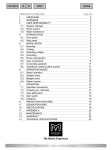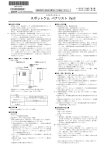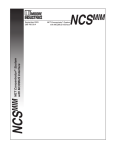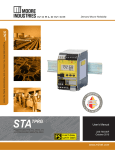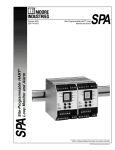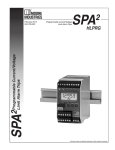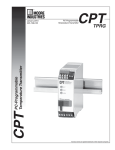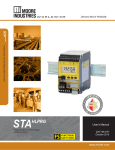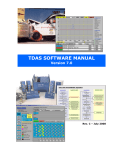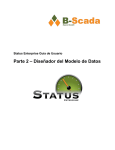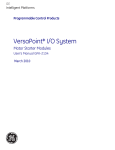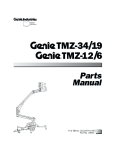Download TMZ_TPRG_Installation_Manual_Moore_Industries
Transcript
June 2004 225-720-02B TMZ PC-Programmable MODBUS Temperature Transmitter TMZ PC-Programmable MODBUS Temperature Transmitter TPRG Left: TMZ TPRG: PC-Programmable MODBUS Temperature Transmitter Right: TMZ HLPRG: PC-Programmable MODBUS Signal Converter All product names are registered trademarks of their respective companies. Table of Contents Introduction .................................................................................................... 4 About this Manual ........................................................................................................... 4 The TMZ ......................................................................................................................... 4 Model and Serial Numbers ............................................................................................. 4 Specifications ................................................................................................ 5 Dimensions ..................................................................................................................... 7 Configuring the TMZ ...................................................................................... 8 Installing the Configuration Software .............................................................................. 9 Connecting the TMZ to the PC ........................................................................................ 9 PC Configuration Software Summary ...................................................... 10 Status and Tool Bar Legend ......................................................................................... 11 Configuration Screens ............................................................................... 12 Input .............................................................................................................................. 12 Trimming ....................................................................................................................... 13 Scaling & Custom Curve ............................................................................................... 13 MODBUS ...................................................................................................................... 15 Installation ................................................................................................... 16 Mounting the TMZ ......................................................................................................... 16 Making the Electrical Connections ................................................................................ 16 Recommended Ground Wiring Practices ...................................................................... 16 CE Conformity............................................................................................................... 16 Operation ..................................................................................................... 16 Maintenance ................................................................................................................. 16 Customer Support ...................................................................................... 16 Appendix A: TMZ MODBUS Register Set ................................................ 17 TMZ PC-Programmable MODBUS Temperature Transmitter The TMZ Introduction This is the users’ manual for the Moore Industries TMZ PC-Programmable MODBUS Temperature Transmitter (TPRG: RTD, T/C, Ohms, mV and Potentiometer inputs). It contains all of the information needed to configure, install, operate and maintain this instrument. About this Manual Wherever you see a “Note”, “Caution” or “WARNING ” pay particular attention. WARNING - Hazardous procedure or condition that could injure the operator. Caution - Hazardous procedure or condition that could damage or destroy the unit. Note - Information that is helpful for a procedure, condition or operation of the unit. The TMZ is a PC-Programmable, user-configurable, signal converter. It has a digital output and retains the high accuracy of an Analog to Digital converter without the limitation of low resolution which is associated with analog outputs. The multi-drop nature of the RS-485 port allows the connection of up to 32 units on a single drop of cable that consists of two pairs of wires. The TMZ has a READY LED to indicate the health of the unit and an INPUT LED to indicate status. Model and Serial Numbers Moore Industries uses the model and serial numbers of our instruments to track all information on each unit that we sell and service. If a problem occurs with your TMZ, check for a tag affixed to the unit listing these numbers. Supply the Customer Support representative with this information when calling. Inputs Refer to Table 4 for input ranges and accuracies of the TMZ (TPRG). Figure 1. The TMZ (TPRG) 1 2 3 4 Outputs READY INPUT RS-232 Port MODBUS Terminals A B S 4 The Interface Solution Experts TMZ PROGAMMABLE MODBUS TRANSMITTER COM The TMZ has a standard RS-485 port that supports the MODBUS RTU protocol. TMZ PC-Programmable MODBUS Temperature Transmitter Specifications Performance Input Accuracy: See Table 4 Overall Accuracy: The overall accuracy of the unit is the input accuracy. It includes the combined effects of linearity, hysteresis, repeatability and adjustment resolution. It does not include ambient temperature effect. For T/C input, add the RJC error. Cold Junction Compensation Accuracy (T/C Inputs Only): ±0.45°C Stability: See Table 1 Response Time: INPUT UPDATE TIME: 128msec; MODBUS POLLING TIME: Dependent upon how fast and how often a MODBUS master requests data Isolation: Standard unit, 1000Vrms between case, input. 1500Vrms between power and input; WITH -RF OPTION, 500Vrms between case, input and power. Power Consumption: 1W max. Input Impedance: T/C and mV inputs, 40Mohms, nominal Performance (continued) Input Over-Range Protection: ±5Vdc Excitation Current (RTD and Ohm Inputs Only): 250µA, ±10% Communications Type: Standard MODBUS RTU protocol interface over RS-485 (parameters as specified in U.S. Standard EIARS485) Address Range: Configurable from 1 to 247. Unit will assume a MODBUS address of 01 by default. Baud Rates: Interface supports the following: 300, 600, 1200, 2400, 4800, 9600, 19.2k and 38.4k Character Format: One start bit, 8 data bits and one stop bit Indicators LED Type: INPUT LED: Dual color LED indicates input failure READY LED: Green LED indicates unit is operating properly Ambient Conditions Weight Operating & Storage Range: -40°C to +85°C (-40°F to +185°F) Effect of Ambient Temperature on Cold Junction Compensation (T/C Inputs Only): ±0.005°C per °C change of ambient temperature Relative Humidity: 0-95%, non-condensing Ambient Temperature Effect: See Table 3 RFI/EMI Immunity (Standard Unit): 10V/m@20-1000MHz, 1kHz when tested according to IEC1000-4-3-1995 WITH -RF OPTION, 30V/m@20-1000MHz, 1kHz AM when tested according to IEC1000-4-3-1995 Noise Rejection: Common mode, 100dB@50/60Hz; Normal mode, Refer to Table 2 290 g (10.2 oz) Specifications and information subject to change without notice. Table 1. Long-Term Stability Stability (% of maximum span) RTD, Ohm & Pot Inputs T/C & mV Inputs Table 3. Ambient Temperature Effect Input-to-Output (Years) Input Type *RTD 0.0035°C 1 3 5 Millivolt 0.5µV + 0.005% of reading 0.09 0.16 0.21 Ohm 0.002ohms + 0.005% of reading 0.08 0.14 0.18 Accuracy per 1°C (1.8°F) change in Ambient Thermocouples Input Type Accuracy per 1°C (1.8°F) change in Ambient J Table 2. Normal Mode Rejection Ratio T/C: J, K, N, C, E T/C: T, R, S, B Pt RTD: 100, 200, 300ohms Pt RTD: 400, 500, 1000ohms Ni: 120ohms Cu: 9.03ohms Max. p-p Voltage Injection for 100dB at 50/60Hz 150mV 80mV 250mV 1V 500mV 100mV Resistance mV 1-4kohms 250-1000 0.25-1kohms 62.5-250 0.125-0.25kohms 31.25-62.5 1V 250mV 100mV Sensor Type 0.00016°C + 0.005% of reading K 0.0002°C + 0.005% of reading E 0.00026°C + 0.005% of reading T 0.0001°C + 0.005% of reading R, S 0.00075°C + 0.005% of reading B 0.0038°C + 0.005% of reading N 0.0003°C + 0.005% of reading C 0.00043°C + 0.005% of reading mV 0.5µV + 0.005% of reading *Accuracy of Ni672 is 0.002°C The Interface Solution Experts 5 TMZ PC-Programmable MODBUS Temperature Transmitter Table 4. Accuracy with RTD, Thermocouple, Ohms, Potentiometer and Millivolt Inputs Input Type α RTD (2-, 3-, 4-Wire) Ohms Conformance Range Input Accuracy/Repeatability Maximum Range 100 200 300 0.003850 400 -200 to 850°C (-328 to 1562°F) -240 to 960°C (-400 to 1760°F) 500 1000 Platinum ±0.1°C (±0.18°F) 100 200 0.003902 -100 to 650°C (-148 to 1202°F) -150 to 720°C (-238 to 1328°F) -200 to 510°C (-328 to 950°F) -80 to 320°C (-112 to 608°F) -50 to 250°C (-58 to 482°F) ±0.85°C (±1.53°F) -240 to 580°C (-400 to 1076°F) -100 to 360°C (-148 to 680°F) -65 to 280°C (-85 to 536°F) 0-4000 0-4000ohms ±0.4ohms 0-4095ohms 4000 max. 0-100% ±0.1% 0-100% 400 500 1000 0.003916 100 Nickel 0.00672 120 Copper 0.00427 9.035 Direct Resistance Ohms n/a Potentiometer T/C mV 6 J n/a n/a -180 to 760°C (-292 to 1400°F) ±0.25°C (±0.45°F) -210 to 770°C (-346 to 1418°F) K n/a n/a -150 to 1370°C (-238 to 2498°F) ±0.30°C (±0.54°F) -270 to 1390°C (-454 to 2534°F) E n/a n/a -170 to 1000°C (-274 to 1832°F) ±0.20°C (±0.36°F) -270 to 1013°C (-454 to 1855.4°F) T n/a n/a -170 to 400°C (-274 to 752°F) ±0.25°C (±0.45°F) -270 to 407°C (-454 to 764.6°F) R n/a n/a 0 to 1760°C (32 to 3200°F) ±0.55°C (±0.99°F) -50 to 1786°C (-58 to 3246.8°F) S n/a n/a 0 to 1760°C (32 to 3200°F) ±0.55°C (±0.99°F) -50 to 1786°C (-58 to 3246.8°F) B n/a n/a 400 to 1820°C (752 to 3308°F) ±0.75°C (±1.35°F) 200 to 1836°C (392 to 3336.8°F) N n/a n/a -130 to 1300°C (-202 to 2372°F) ±0.40°C (±0.72°F) -270 to 1316°C (-454 to 2400.8°F) C n/a n/a 0 to 2300°C (32 to 4172°F) ±0.80°C (±1.44°F) 0 to 2338°C (32 to 4240.4°F) mV n/a n/a n/a ±15µV -50 to 1000mV The Interface Solution Experts TMZ PC-Programmable MODBUS Temperature Transmitter Figure 2. TMZ (TPRG) Dimensions 138mm (5.43 in) WHEN INSTALLED 133mm (5.24 in) 25mm (1.00 in) 1 2 READY INPUT WHEN INSTALLED 126mm (4.97 in) 3 4 TMZ 52mm (2.05 in) PROGAMMABLE MODBUS TRANSMITTER 100mm (3.94 in) C L COM 48mm (1.89 in) Table 5. Terminal Designations Top Terminals (Left to Right) Input Type T1 T2 T3 T4 KEY: RTD, Ohms, Potentiometer, T/C & mV Inputs See Figure 3 Bottom Terminals (Left to Right) Row 1 Row 2 MODBUS Output Power B1 B2 B3 B4 A B S Not Used Not Used Not Used + – A = A MODBUS B = B MODUBUS S = S MODBUS + = Positive power input – = Negative power input NOTES: 1. Terminal blocks can accommodate 14-22 AWG solid wiring. Figure 3. Temperature Sensor Hook-Up Guide Thermocouple and Millivolt Input + 2-Wire RTD or Decade Resistance Box 3-Wire RTD or Decade Resistance Box 4-Wire RTD or Decade Resistance Box Potentiometer Input 1 234 1 2 3 4 1 234 1 234 – 12 3 4 The Interface Solution Experts 7 TMZ PC-Programmable MODBUS Temperature Transmitter Figure 4. Hooking-Up the TMZ (TPRG) MILLIVOLT _ SOURCE OR T/C + SIMULATOR MODBUS Host TO SERIAL (COM) PORT OF PC OHMS OR 2-WIRE RTD SIMULATOR 1 2 READY INPUT 3 4 PC TMZ PROGAMMABLE MODBUS TRANSMITTER COM TO SERIAL (COM) PORT OF PC RS-485/RS-232 A B Converter S MODBUS OUTPUT 24Vdc POWER + SUPPLY – INPUT HOOKUP CONNECTIONS 4-Wire RTD or Decade Resistance Input 3-Wire RTD or Decade Resistance Input OHMS OR RTD SIMULATOR OHMS OR RTD SIMULATOR Configuring the TMZ One of the benefits of the TMZ is that there are no internal or external controls to adjust or settings to change. All operating parameters are set using a PC and Moore Industries’ Intelligent PC Configuration Software. 8 The Interface Solution Experts Potentiometer Input The software settings are downloaded to the transmitter in the form of a Configuration File and stored in the instrument’s memory. You can save a backup copy of the file on your PC hard drive or disk. The transmitter communicates with the PC through an RS-232 connection to the PC’s serial port or through the MODBUS output with a fixed baud rate at 19.2k. TMZ PC-Programmable MODBUS Temperature Transmitter Installing the Configuration Software This makes it easy to create a set of operating parameters, save them to disk, and download them to one or more transmitters at a later time. Refer to Table 6 for the equipment needed. 1. Insert the Moore Industries Interface Solution PC Configuration Software CD into the CD drive of the PC. Access the CD and open the “TMZ PC Configuration Software” folder. The TMZ must be connected to the PC in order to: perform sensor trimming; assign a tag, descriptor or message; receive (via download) a configuration file; and save the configuration file from the transmitter’s memory. 2. Double-click the installation program located in the folder. Follow the prompts to correctly install the program. Connecting the TMZ to the PC Once the Configuration Program is installed on the PC, the TMZ can be connected to equipment to simulate input and monitor output. You can then change the transmitter’s operating parameters. Connect the RS-232 end of the cable to the PC’s COM port. See Table 6 for information on the necessary equipment. No Transmitter Needed It is not necessary to connect the transmitter to a PC to create configuration files using the software. The Configuration Program can be run without connecting a transmitter, and most parameters can be set without the benefit of input from a sensor or TMZ. Table 6. Assembling the equipment needed to configure the TMZ (TPRG) Device Specifications Variable Input Simulator for Thermocouple, RTD, Millivolt, Potentiometer, or Decade Variable; Accurate to ±0.05% of unit span Resistance Box Power Supply 24Vdc, ±10% 80386-based(or faster) IBM PC, or 100% compatible; 1.44Mb floppy diskette drive 4Mb free RAM; 8Mb recommended; 20Mb free disk space on hard drive (More RAM & hard disk space is required for Windows 98, NT 2000 or XP) Personal Computer Microsoft Windows® 95, 98, NT, 2000 or XP Internet Explorer 3.0+ 1 (one) serial port (COM 1, 2, 3, or 4) set to 19.2k baud, no parity, 8 data bits, and 1 stop bit Moore Industries PC Version 1.0 or greater, successfully installed to the hard drive Configuration Software Communication Cable Part# 803-053-26 The Interface Solution Experts 9 TMZ PC-Programmable MODBUS Temperature Transmitter PC Configuration Software Summary Figure 5. TMZ (TPRG) PC Configuration Software Screen 1 10 6 2 11 12 13 3 7 4 5 8 9 Once the default configuration has been saved to disk, it is safe to program other parameters. The PC Software is made up of these sections: 1. Tool Bar/Status Bar– Dropdown menus and corresponding icons allow you to perform various functions throughout the PC Configuration Program. Refer to the Status and Tool Bar Legend section for a complete description. 2. Program Status– This portion of the program displays the activity (idle, monitoring, downloading, uploading) of the connected unit. 3. Device ID– Displays your unit configuration (HLPRG/TPRG), ID, Hardware revision and Software revision. 10 The Interface Solution Experts 4. Identification Parameters– Use this parameter to place an identifying “Tag” (8 alphanumeric characters max.), “Descriptor” (16 alphanumeric characters max.) or “Message” (32 alphanumeric characters max.). You may also use the Quick Set feature to set your Tag and download it. Simply click the button in the Tool Bar. 5. Device Configuration– Displays the Input and MODBUS parameters you have chosen as settings for your TMZ. 6. Input Type– Select your input type (RTD, T/C, Ohms, mV and Potentiometer) and characteristics. 7. Variables– Displays the value of the Process Variable that is being monitored, the Reference Junction temperature, the scaled output and the Custom Curve output. TMZ PC-Programmable MODBUS Temperature Transmitter 8. Device Status– Notifies of any errors or conditions which are outside of tolerance range. 9. Communications– Indicates current PC connection/communications status. 10. Input– Use this tab to set your input parameters. Refer to the Input section for a complete description. 11. Trimming– This parameter allows you to configure and perform sensor trimming. Refer to the Trimming section for a complete description. 12. Scaling & Custom Curve– Use this portion of the screen to set up your custom curve table. Refer to the Scaling & Custom Curve section for a complete description. 13. MODBUS– Allows you to configure your MODBUS parameters. Refer to the MODBUS section for a complete description. Status and Tool Bar Legend Allows such functions as New, Open, Save and Print Allows you to Upload and Download configurations Select the PC Port (Comm Port) that you will use Allows you to Monitor and Stop monitoring processes Provides functions specific to your Custom Curve table Controls whether Tool and Status Bars are viewed on the screen Displays the version of the TMZ Configuration Program Quick Set Buttons The Interface Solution Experts 11 TMZ PC-Programmable MODBUS Temperature Transmitter Configuration Screens Input Figure 6. Input Tab Running Average Filter– This function is for filtering the input signal. The TMZ provides this filter with a user-selected range between 1 and 16. Factory default is 4. Note: A higher Running Average Filter setting provides smoother output transitions however, reduces response time. Conversely, a lower setting provides a faster response time, but may seem more unstable. Input Filter– This setting is used to configure the input filter. This filter is designed to reduce the effects of mains-induced noise. The input filter frequency value should be set to the frequency of the local AC supply-either 50Hz or 60Hz. Note: Once you have configured all parameters, download to the unit by selecting “Download” in the Transfer dropdown menu located in the Status Bar. You may also download by clicking the button in the Tool Bar. Input Range– Allows you to set your “Upper Range Value” (URV) and “Lower Range Value” (LRV) depending upon the input configuration and range chosen in the Input Type section. Temperature Measurements– Select the unit in which you wish your Input Range displayed. Choose from Deg C, Deg F, Kelvin or Deg R. Broken Wire– Allows the TMZ to continuously test the integrity of your sensor wiring by sending out random microamp pulses during operation. If a problem is detected, a message is displayed in the Device Status box. 12 The Interface Solution Experts You may also use the Quick Set feature to configure your Input parameters and download the settings. Configure your parameters and click the button, located in the Tool Bar. The input settings you have chosen will be applied and downloaded to your unit. TMZ PC-Programmable MODBUS Temperature Transmitter Trimming Figure 7. Trimming Tab Note: Once you have configured all parameters, download to the unit by selecting “Download” in the Transfer dropdown menu located in the Status Bar. You may also download by clicking the button in the Tool Bar. Scaling & Custom Curve Figure 8. Scaling & Custom Curve Tab Sensor Trimming– Sensor Trimming increases the measurement accuracy of your instrument by matching the reading of its actual input to either a calibrated source or the device to which it is connected. This verifies that the input from the sensor to the transmitter is being interpreted correctly. You may trim any point between 0% and 100% along the scale. Note that one-point trimming applies an offset to the sensor reading, while two-point trimming applies both an offset and a gain. Follow the steps below in order to perform sensor trimming. 1. Select either “1 Point” (one-point trimming) or “2 Points” (two-point trimming) by clicking the appropriate button. Each pair consists of “Set” and “Trim” values. 2. Enter the values that need to be trimmed into the “Set Value” field and click “Set”. 3. Apply the targeted signal to the input, wait until it settles and click “Trim” to capture the measured value. If you chose “2 Points”, repeat the step above for the second point. Scaling– Scaling allows you to take your PV (Process Variable) reading and manipulate it to a more customized display range (Scaled PV). PV is the unit read after selecting your input type. For example, choosing a mV input would then produce a PV displayed in mV. Should you require a Scaled PV, follow the instructions below. 1. In the “PV” parameter, enter the actual range of your input type. Place the minimum value in the “LRV” text box and the maximum value in the “URV” box. 2. In the “Scaled PV” parameter, enter the scale, or range you require. In the “LRV” text box, enter the value that you wish displayed when your reading is at its minimum. In the “URV” text box, place the value to be displayed when the process variable has reached maximum. The Interface Solution Experts 13 TMZ PC-Programmable MODBUS Temperature Transmitter You may also use the Quick Set feature to configure your Scaling parameters and download the settings. To create a custom curve: 1. Click the “Enabled” box . Configure your parameters and click the button, located in the Tool Bar. The settings you have chosen will be applied and downloaded to your unit. Custom Curve– The Custom Curve feature allows you to setup your own custom curve table. This allows you to tell the transmitter what it should output when it receives a certain input. This feature also allows you the ability to write a table in Microsoft® Excel, save it in a .csv format, and import it into the Configuration Software. This makes it simple to save the custom table for downloading to multiple units or for backup purposes. 2. Select the number of points for your curve (32 points maximum). 3. Type your individual values in the X and Y columns. Source variables are inserted into the X column while the corresponding data is inserted into the Y column. 4. After all of your data has been entered, you must use the Custom Curve dropdown menu to save your newly created custom (“Save Custom Curve”) and to download it to your TMZ (“Download Custom Curve”). Note: Once you have configured all parameters, download to the unit by selecting “Download” in the Transfer dropdown menu located in the Status Bar. You may also download by clicking the button in the Tool Bar. However, this does not download your custom table. To do so, you must use the Custom Curve dropdown menu. 14 The Interface Solution Experts TMZ PC-Programmable MODBUS Temperature Transmitter MODBUS Data Format– Allows you to select the word order and number of decimal places you choose. Figure 9. MODBUS Tab Selecting LSW (Normal), Least Significant Word, stores the most signifcant bits in the second register and the least significant bits in the first register (factory default). MSW (Reversed), Most Significant Word, reverses the above order. The most significant bits will be stored in the first register with the least significant bits stored in the second register. No of DPs in integer- This is a calculation that stores a more accurate value in the MODBUS register and offers better resolution. Select your value using the up and down arrows to the right of the display. See below for an example of this process. PV = 123.456789 Communications– Used to set MODBUS Address, Baud Rate and Parity parameters. Address- The number that the TMZ uses to identify itself on the MODBUS network. It is configurable from 1 to 247. By default, the assigned MODBUS address is 01. Baud Rate- The speed of data transmission. It should be set to match the baud rate of the attached controller. Supported Baud Rates include: 300, 600, 1200, 2400, 4800, 9600, 19.2k and 38.4k. Factory default is 9600. Parity- A method in serial asynchronous communications of “checking” that characters have been sent correctly. Even, Odd and no Parity (None) are supported. Factory default is None. "No of DPs in integer" Value Displayed Integer 1234 1 2 12345 123456 3 Note: Once you have configured all parameters, download to the unit by selecting “Download” in the Transfer dropdown menu located in the Status Bar. You may also download by clicking the button in the Tool Bar. You may also use the Quick Set feature to configure your MODBUS parameters and download the settings. Configure your parameters and click the button, located in the Tool Bar. The settings you have chosen will be applied and downloaded to your unit. The Interface Solution Experts 15 TMZ PC-Programmable MODBUS Temperature Transmitter Installation Operation Installation consists of physically mounting the unit and completing the electrical connections. Once programmed, calibrated, installed, and supplied with the correct power, the TMZ transmitter begins to operate immediately. Depending upon environmental conditions, it can be expected to operate unattended for extended periods of time. Mounting the TMZ The TMZ can be mounted on standard DIN mounting rails. Maintenance Making the Electrical Connections Please refer to Figure 4 for electrical connections. Recommended Ground Wiring Practices Moore Industries recommends the following ground wiring practices: • Any Moore Industries product in a metal case or housing should be grounded. • The protective earth conductor must be connected to a system safety earth ground before making any other connections. • All input signals to, and output signals from, Moore Industries’ products should be wired using a shielded, twisted pair technique. Shields are to be connected to an earth or safety ground at the unit itself. • The maximum length of unshielded input and/or output signal wiring should be two inches. CE Conformity Installation of any Moore Industries’ products that carry the CE certification must adhere to the guidelines above in order to meet the requirements set forth in applicable EMC directive (EN 61326-1). Consult the factory for the most current information on products that have been CE certified. 16 The Interface Solution Experts Moore Industries suggests a check for terminal tightness and general unit condition every 6-8 months. Always adhere to any site requirements for programmed maintenance. Customer Support Moore Industries is recognized as the industry leader in delivering top quality to its customers in products and services. We perform a battery of stringent quality assurance checks on every unit we ship. If any Moore Industries product fails to perform up to rated specifications, call us for help. Our highly skilled staff of trained technicians and engineers pride themselves on their ability to provide timely, accurate and practical answers to your process instrumentation questions. Factory phone numbers are listed on the back cover of this manual. If problems involve a particular TMZ (TPRG), there are several pieces of information that can be gathered before you call the factory that will help our staff get the answers you need in the shortest time possible. For the fastest service, gather the complete model and serial number(s) of the problem unit(s) and the job number of the original sale. TMZ PC-Programmable MODBUS Temperature Transmitter Appendix A: TMZ MODBUS Register Set Table A-1 contains all of the MODBUS integer registers supported by the TMZ. These registers constitute both the 30000 and 40000 register set. Table A-1. MODBUS Register Table Register Variable Read Description 0 1 2 3 4 5 6 256-257 258-259 260-261 262-263 264-265 266 267 PV SV PercentOfRange ScaledPV LinearedPV ErrorStatus PV_STATUS PV SV PercentOfRange ScaledPV LinearedPV ErrorStatus PV_STATUS R R R R R R R R R R R R R R PV (integer) SV (integer) Percent of range (integer) Scaled PV (integer) Linearised PV (integer) TMZ Error / Status Word UFE PV Status PV (float) SV (float) Percent of Range (float) Scaled PV (float) Linearised PV (float) TMZ Error / Status Word (*) UFE PV Status The Interface Solution Experts 17 Declaration of Conformity EMC Directive 89/336/EEC • Manufacturer’s Name: • Manufacturer’s Address: Moore Industries-International, Inc. 16650 Schoenborn Street North Hills, CA 91343-6196 USA Declares that the product(s): • Product Name: TMZ MODEL / • Model Number(s): TMZ INPUT / OUTPUT * * / POWER 20-30Vdc / OPTIONS / * HOUSING [DIN] * Indicates any input, output, power, option and housing as listed on the product data sheet • Conforms to the following EMC specifications: EN 61326-1, 1998, Electromagnetic Compatibility requirements for electrical equipment for control use • Supplementary Information: None September 25, 2003 Date Fred Adt Quality Assurance Director Robert Stockham Moore Industries-Europe General Mgr. European Contact: Your Local Moore Industries Sales and Service Office RETURN PROCEDURES To return equipment to Moore Industries for repair, follow these four steps: 1. Call Moore Industries and request a Returned Material Authorization (RMA) number. Warranty Repair – If you are unsure if your unit is still under warranty, we can use the unit’s serial number to verify the warranty status for you over the phone. Be sure to include the RMA number on all documentation. Non-Warranty Repair – If your unit is out of warranty, be prepared to give us a Purchase Order number when you call. In most cases, we will be able to quote you the repair costs at that time. The repair price you are quoted will be a “Not To Exceed” price, which means that the actual repair costs may be less than the quote. Be sure to include the RMA number on all documentation. 2. Provide us with the following documentation: a) A note listing the symptoms that indicate the unit needs repair b) Complete shipping information for return of the equipment after repair c) The name and phone number of the person to contact if questions arise at the factory 3. Use sufficient packing material and carefully pack the equipment in a sturdy shipping container. 4. Ship the equipment to the Moore Industries location nearest you. The returned equipment will be inspected and tested at the factory. A Moore Industries representative will contact the person designated on your documentation if more information is needed. The repaired equipment, or its replacement, will be returned to you in accordance with the shipping instructions furnished in your documentation. WARRANTY DISCLAIMER THE COMPANY MAKES NO EXPRESS, IMPLIED OR STATUTORY WARRANTIES (INCLUDING ANY WARRANTY OF MERCHANTABILITY OR OF FITNESS FOR A PARTICULAR PURPOSE) WITH RESPECT TO ANY GOODS OR SERVICES SOLD BY THE COMPANY. THE COMPANY DISCLAIMS ALL WARRANTIES ARISING FROM ANY COURSE OF DEALING OR TRADE USAGE, AND ANY BUYER OF GOODS OR SERVICES FROM THE COMPANY ACKNOWLEDGES THAT THERE ARE NO WARRANTIES IMPLIED BY CUSTOM OR USAGE IN THE TRADE OF THE BUYER AND OF THE COMPANY, AND THAT ANY PRIOR DEALINGS OF THE BUYER WITH THE COMPANY DO NOT IMPLY THAT THE COMPANY WARRANTS THE GOODS OR SERVICES IN ANY WAY. ANY BUYER OF GOODS OR SERVICES FROM THE COMPANY AGREES WITH THE COMPANY THAT THE SOLE AND EXCLUSIVE REMEDIES FOR BREACH OF ANY WARRANTY CONCERNING THE GOODS OR SERVICES SHALL BE FOR THE COMPANY, AT ITS OPTION, TO REPAIR OR REPLACE THE GOODS OR SERVICES OR REFUND THE PURCHASE PRICE. THE COMPANY SHALL IN NO EVENT BE LIABLE FOR ANY CONSEQUENTIAL OR INCIDENTAL DAMAGES EVEN IF THE COMPANY FAILS IN ANY ATTEMPT TO REMEDY DEFECTS IN THE GOODS OR SERVICES , BUT IN SUCH CASE THE BUYER SHALL BE ENTITLED TO NO MORE THAN A REFUND OF ALL MONIES PAID TO THE COMPANY BY THE BUYER FOR PURCHASE OF THE GOODS OR SERVICES. United States • [email protected] Tel: (818) 894-7111 • FAX: (818) 891-2816 Australia • [email protected] Tel: (02) 8536-7200 • FAX: (02) 9525-7296 © 2007 Moore Industries-International, Inc. ANY CAUSE OF ACTION FOR BREACH OF ANY WARRANTY BY THE COMPANY SHALL BE BARRED UNLESS THE COMPANY RECEIVES FROM THE BUYER A WRITTEN NOTICE OF THE ALLEGED DEFECT OR BREACH WITHIN TEN DAYS FROM THE EARLIEST DATE ON WHICH THE BUYER COULD REASONABLY HAVE DISCOVERED THE ALLEGED DEFECT OR BREACH, AND NO ACTION FOR THE BREACH OF ANY WARRANTY SHALL BE COMMENCED BY THE BUYER ANY LATER THAN TWELVE MONTHS FROM THE EARLIEST DATE ON WHICH THE BUYER COULD REASONABLY HAVE DISCOVERED THE ALLEGED DEFECT OR BREACH. RETURN POLICY For a period of thirty-six (36) months from the date of shipment, and under normal conditions of use and service, Moore Industries ("The Company") will at its option replace, repair or refund the purchase price for any of its manufactured products found, upon return to the Company (transportation charges prepaid and otherwise in accordance with the return procedures established by The Company), to be defective in material or workmanship. This policy extends to the original Buyer only and not to Buyer's customers or the users of Buyer's products, unless Buyer is an engineering contractor in which case the policy shall extend to Buyer's immediate customer only. This policy shall not apply if the product has been subject to alteration, misuse, accident, neglect or improper application, installation, or operation. THE COMPANY SHALL IN NO EVENT BE LIABLE FOR ANY INCIDENTAL OR CONSEQUENTIAL DAMAGES. Belgium • [email protected] Tel: 03/448.10.18 • FAX: 03/440.17.97 The Netherlands • [email protected] Tel: (0)344-617971 • FAX: (0)344-615920 China • [email protected] Tel: 86-21-62491499 • FAX: 86-21-62490635 United Kingdom • [email protected] Tel: 01293 514488 • FAX: 01293 536852 Specifications and Information subject to change without notice. User’s Manual Supplement TMZ (2TPRG) Dual Input Model with -SP2 Option in IP Housing November 2004 Information contained within this supplement accompanies data in the TMZ (TPRG) User’s Manual, 225-72002, Revision B. This document addresses the TMZ (2TPRG) dual input model of the TMZ with the -SP2 Option and enclosed in an IP Housing. The TMZ (2TPRG) has a single MODBUS port. It also has two alarm relays and two inputs which provide two measurements per instrument. Inputs are individually configurable. The -SP2 Option refers to a special 5mA excitation current feature for RTD Cu0427. This is provided to allow a more stable measurement with this RTD. IP Housing refers to the orientation of input and output terminals in which power and output/relay terminals are located on the top of the instrument while input terminals are located at the bottom. Figure S-1. The TMZ (TPRG) Dual Input in the IP Housing TMZ PROGAMMABLE MODBUS TRANSMITTER ALARM 2 ALARM 1 INPUT 2 INPUT 1 READY Note: Unless otherwise stated, all specifications, tolerances and operating parameters for both inputs adhere to those described in the TMZ (TPRG) User’s Manual. The Interface Solution Experts © 2004 Moore Industries-International, Inc. 225-720-03A 1 User’s Manual Supplement TMZ (2TPRG) Dual Input Model with -SP2 Option in IP Housing Figure S-2. Dimensions of the TMZ (2TPRG) in the IP Housing WHEN INSTALLED 138mm (5.43 in) WHEN INSTALLED 133mm (5.24 in) 45mm (1.77 in) 126mm (4.97 in) 52mm (2.05 in) TMZ PROGAMMABLE MODBUS TRANSMITTER 100mm (3.94 in) ALARM 2 ALARM 1 INPUT 2 INPUT 1 C L 48mm (1.89 in) READY Table S-1. Terminal Designations of the TMZ (2TPRG) in the IP Housing Top Terminals (Left to Right) Power/Output T1 T2 T3 T4 T5 T6 T7 T8 DCC DC NC2 CM2 NO2 NC1 CM1 NO1 Middle Terminals (Left to Right) MODBUS Output M1 M2 M3 M4 Not Used Not Used Not Used Not Used M5 S M6 M7 B A KEY: DC = Positve power input DCC = Negative power input NC = Normally Closed CM = Relay Common NO = Normally Open Bottom Terminals (Left to Right) Input B1 RTD Inputs NOTES: 1. Terminal blocks can accommodate 14-22 AWG solid wiring. 2 The Interface Solution Experts B2 B3 See Input Hook-Up Connections portion of Figure S-3 B4 B5 B6 B7 See Input Hook-Up Connections portion of Figure S-3 B8 S = S MODBUS B = B MODBUS A = A MODBUS User’s Manual Supplement TMZ (2TPRG) Dual Input Model with -SP2 Option in IP Housing Figure S-3. Hooking-Up the TMZ (2TPRG) in the IP Housing MODBUS Host TO SERIAL (COM) PORT OF PC 24Vdc POWER SUPPLY – + PC RS-485/RS-232 S B Converter A TMZ MODBUS OUTPUT PROGAMMABLE MODBUS TRANSMITTER TO SERIAL (COM) PORT OF PC ALARM 2 ALARM 1 INPUT 2 INPUT 1 READY 4 3 2 1 4 3 2 1 2-WIRE RTD SIMULATOR 2-WIRE RTD SIMULATOR INPUT HOOK-UP CONNECTIONS 2-Wire RTD or Decade Resistance Box 3-Wire RTD or Decade Resistance Box 4-Wire RTD or Decade Resistance Box 4 3 2 1 4 3 2 1 4 3 2 1 The Interface Solution Experts 3 User’s Manual Supplement TMZ (2TPRG) Dual Input Model with -SP2 Option in IP Housing PC Configuration Software Summary of TMZ (2TPRG) Dual Input with -SP2 Option Figure S-4. Main Screen of the TMZ (TPRG) PC Configuration Software Program for Dual Input Units Configured with the -SP2 Option 1 8 2 9 10 11 3 4 5 6 7 Once the default configuration has been saved to disk, it is safe to program other parameters. The PC Software is made up of these sections: 6. TMZ Device Info– Displays your unit configuration, ID, Hardware revision and Software revision. 7. Communications– Indicates current PC connection/communications status. 1. Tool Bar/Status Bar– Dropdown menus and corresponding icons allow you to perform various functions throughout the PC Configuration Program. Refer to the Status and Tool Bar Legend section of this document for a complete description. 8. Input 1 / Input 2 Tabs– Use these tabs to set your input parameters. Refer to the Input 1 / Input 2 section for a complete description. 2. Program Status– This portion of the program displays the activity (idle, monitoring, downloading, uploading) of the connected unit. 9. Scaling Tab– Use this portion of the screen to scale your instrument. Refer to the Scaling section for a complete description. 3. TMZ Status– Notifies of any errors or conditions which are outside of tolerance range. 10. Alarms 1 & 2 Tab– Use this tab to set up your alarms. Refer to the Alarms section of this document for a complete description. 4. Process Variable (PV)– Displays the values of the process variables that are being monitored. 5. Identification Parameters– Use this parameter to place an identifying “Tag” (8 alphanumeric characters max.), “Descriptor” (16 alphanumeric characters max.) or “Message” (32 alphanumeric characters max.). 4 The Interface Solution Experts 11. MODBUS– Allows you to configure your MODBUS parameters. Refer to the MODBUS section of TMZ (TPRG) User’s Manual (Page 15) for a complete description. User’s Manual Supplement TMZ (2TPRG) Dual Input Model with -SP2 Option in IP Housing Status and Tool Bar Legend Configuration Screens Allows such functions as New, Open, Save and Print Input 1 / Input 2 Controls whether Tool and Status Bars are viewed on the screen Figure S-5. Input 1 / Input 2 Tab Allows you to Upload and Download configurations Select the PC Port (Comm Port) that you will use Allows you to Monitor and Stop monitoring processes Displays the version of the TMZ Configuration Program Note: Sensor Trimming for each input to be trimmed is now performed at the respective Input tab (Input 1 or Input 2). Configuration remains as described in the TMZ (TPRG) User’s Manual (Page 13). In appearance, windows for both Input 1 and Input 2 are the same. They are configured similarly for the specific input chosen. Configuration of the Input windows follows the general parameters, with slight variation, as described in the TMZ (TPRG) User’s Manual (Page 12). Input Type– Select your input type (RTD 2 Wire, RTD 3 Wire or RTD 4 Wire). The Sensor Range section will adjust according to the parameters that have been set. Temperature, Filter, Broken Wire Detection and Running Average Filter Settings configuration remains as described in the TMZ (TPRG) User’s Manual (Page 12). The Interface Solution Experts 5 User’s Manual Supplement TMZ (2TPRG) Dual Input Model with -SP2 Option in IP Housing Scaling Note: The Custom Curve feature is not available with the TMZ (2TPRG). Alarms 1 & 2 Figure S-7. Alarms 1 & 2 Tab Figure S-6. Scaling Tab Mode– Click the appropriate button to configure your alarm as a Trip or Fault. The following instructions apply to Channel 1 and Channel 2 Scaling configuration. Trip– Notifies you if your process input drops below, or exceeds your trip point setting. 1. Select the “Enabled” checkbox of the channel you are configuring. Fault– Alerts the user of a fault whenever one has been sensed. To scale the zero and full range span of your sensor, perform the following steps in the “Sensor Range” parameter. 2. Place the value you want displayed as the low, or zero end of your range in the “Zero” textbox. 3. Place the upper, or full range value in the “Full” textbox. To scale the zero and full range span of your process variable reading, perform the following steps in the “Process Variable” parameter. 4. Place the value you want displayed as the low, or zero end of your range in the “Zero” textbox. 5. Place the upper, or full range value in the “Full” textbox. Trip Alarm Choosing the Trip Alarm, you are prompted to complete the following fields: Input Failure– Check the appropriate box in order for your alarm to trip at a failure at Input 1, Input 2 or both. Source Channel– From the dropdown menu, select the process variable to be used as reference for your selected trip point value. You may select Channel 1, Channel 2 or both. Trip Point– The reference value used for notification. In choosing your limits, you are setting the parameters for your unit to notify you if your process input drops below (Low Alarm) or exceeds (High Alarm) your trip point setting. 1. Select the “High Alarm” or “Low Alarm” button. 6 The Interface Solution Experts User’s Manual Supplement TMZ (2TPRG) Dual Input Model with -SP2 Option in IP Housing 2. Enter the value you wish set as the trip point in the “Trip Point” text box. Dead Band– The Dead Band is the range in which an alarm relay remains in an alarm condition even after the monitored process variable input has returned to a safe level, at or below/above the trip point setting. MODBUS MODBUS configuration remains unchanged as described in the TMZ (TPRG) User’s Manual (Page15). 3. If choosing to use a dead band value, enter it into the “Dead Band” text box Delay– When your unit is in an alarm condition, the delay is the amount of time you set (0-120sec) to elapse before a relay trip. 4. Enter your delay time into the “Delay” text box. Fail Safe/Non Fail Safe– A Fail Safe alarm, if in the alarm condition, will remain in the alarm condition even if power to the unit is removed. Its alarm trip relays are energized whenever the process input is in a non-alarm condition (including any dead band setting). These relays de-energize when the process input trips the alarm. Non Fail Safe alarm trip relays are energized whenever the process input is in an alarm condition. These relays de-energize when the process input returns to the reset point (including any dead band). Fault Alarm The Fault Alarm enables the fields outlined below. 1. Select the type of Fault Alarm you require in your application. Input Failure– Check the appropriate box in order for your alarm to notify you of a failure at Input 1, Input 2 or both. Input Saturation– Should the input become overloaded, or saturated, your alarm would activate. TMZ Failure– Choosing this parameter activates the alarm at any internal failure that occurs in the TMZ itself. 2. Enter your Delay value. Refer to the Trip Alarm section for further explanation. 3. Select a Fail Safe or Non Fail Safe alarm, and click the corresponding button. Refer to the Trip Alarm section for further explanation. The Interface Solution Experts 7 User’s Manual Supplement TMZ (2TPRG) Dual Input Model with -SP2 Option in IP Housing TMZ MODBUS Register Set Table S-2 contains all of the MODBUS integer registers supported by the TMZ (2TPRG) dual input model. These registers constitute both the 30000 and 40000 register set. Table S-2. MODBUS Register Table Register Variable Read/ Write Description 0 1 2 3 4 5 6 7 8 9 PV1 PV2 SV1 SV2 PercentOfRange1 PercentOfRange2 ErrorStatus Measured PV channel 1 Measured PV channel 2 ErrorStatus2 R R R R R R R R R R PV1 (integer) PV2 (integer) SV1 (integer) SV2 (integer) Percent of range channel 1 (integer) Percent of range channel 2 (integer) TMZ dual input status information Raw measurement from front-end channel 1 Raw measurement from front-end channel 2 TMZ dual input additional status information 256-257 258-259 260-261 262-263 264-265 266-267 268 269 512 513 PV1 PV2 SV1 SV2 PercentOfRange1 PercentOfRange2 ErrorStatus ErrorStatus2 TMZ_OffLine Model Type R R R R R R R R R R PV1 (float) PV2 (float) SV1 (float) SV2 (float) Percent of range channel 1 (float) Percent of range channel 2 (float) TMZ dual input status information TMZ dual input additional status information TMZ on line (0) off line (1) mode Model Type 0 = low level (single input) 1= high level (single input) 2 = special RTD (single input) 3 = low level dual input 4 = high level dual input 5 = special RTD dual input 514 Channel 1 mode W MSB = measurement mode, LSB = sensor type code Measurement mode: 1 = RTD 2 wire 2 = RTD 3 wire 3 = RTD 4 wire 4 = mV 5 = resistance 2 wire 6 = resistance 3 wire 7 = resistance 4 wire 8 = thermocouple with no RJC compensation 9 = thermocouple 10 = potentiometer 17 = current 18 = voltage Table continued on next page 8 The Interface Solution Experts User’s Manual Supplement TMZ (2TPRG) Dual Input Model with -SP2 Option in IP Housing MSB = byte 3, LSB = byte 4 MSB = measurement mode, LSB = sensor type code MSB = byte 3, LSB = byte 4 MSB = PV units, LSB = SV units MSB = PV units, LSB = SV units LSB = MODBUS address (1-247) MODBUS baud rate: 0 = 300 baud 1 = 600 baud 2 = 1200 baud 7 = 38400 baud MODBUS parity: 0 = none 1 = odd 2 = even MODBUS floating point mode: 0 = MSW first 1 = LSW first Writing any value causes channel 1’s trimming to be reset 515 516 517 518 519 520 521 Channel 1 configuration Channel 2 mode Channel 2 configuration Channel 1 units of measure Channel 2 units of measure MODBUS address MODBUS baud rate W W W W W W W 522 MODBUS parity W 523 MODBUS float format W 526 Reset channel 1 trimming W 527 Reset channel 2 trimming W 528 Channel1_Trim_Lower W 529 Channel1_Trim_Upper W 530 Channel2_Trim_Lower W Writing any value to this register causes the TMZ dual input to trim the channel 2 lower point 531 Channel2_Trim_Upper W Writing any value to this register causes the TMZ dual input to trim the channel 2 upper point Writing any value causes channel 2’s trimming to be reset Writing any value to this register causes the TMZ dual input to trim the channel 1 lower point Writing any value to this register causes the TMZ dual input to trim the channel 1 upper point 9 The and Interface Solution Experts Specifications information subject to change without notice.





























